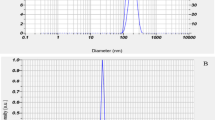Abstract
Purpose. The role of crystal habit in influencing the physical stability and pharmacokinetics of trimethoprim suspensions was examined.
Methods. Different habits of trimethoprim (TMP) were obtained by recrystallizing the commercial sample (PD) utilizing solvent-change precipitation method. Four distinct habits (microscopic observation) belonging to the same polymorphic state (DSC studies) were selected for studies. Preformulation and formulation studies were carried out on suspension dosage forms containing these crystals. The freshly prepared suspensions were also evaluated for their pharmacokinetic behaviour on healthy human volunteers using a cross over study.
Results. Variation of crystallization conditions produces different habits of TMP. Among the different crystal habits exhibiting same polymorphic state, the most anisometric crystal showed best physical stability in terms of sedimentation volume and redispersibility. However, habit did not significantly affect the extent of TMP excreted in urine.
Conclusions. Modification of surface morphology without significantly altering the polymorphic state can be utilized for improving physical stability of TMP suspensions. However, the pharmacokinetic profile remains unaltered.
Similar content being viewed by others
REFERENCES
J. K. Haleblian. Characterization of habits and crystalline modification of solids and their pharmaceutical applications. J. Pharm. Sci. 64:1269–1288 (1975).
H. Takubo, S. Kume, and M. Koizumi. Relationships between supersaturation, solution velocity, crystal habit and growth rate in crystallization of ammonium phosphate. J. Cryst. Growth. 67:217–226 (1984).
J. Jaffe and N. E. Foss. Compression of crystalline substances. J. Am. Pharm. Assoc. Sci. ed. XLVIII:26–29 (1959).
J. W. Shell. X-ray and crystallographic applications in pharmaceutical research. III. Crystal habit quantitation. J. Pharm. Sci. 52:100–101 (1963).
O. Alpar, J. A. Hersey, and E. Shotton. Compression properties of lactose. J. Pharm. Pharmacol. 22S:1S–7S (1970).
E. Shotton and B. A. Obiorah. Effect of particle shape and crystal habit on properties of sodium chloride. J. Pharm. Pharmacol. 25S:37p–43 p (1973).
M. P. Summers, R. P. Enever, and J. E. Carless. Influence of crystal form on radial stress transmission characteristics of pharmaceutical materials. J. Pharm. Pharmacol. 28:89–99 (1976).
R. E. Gordon and S. I. Amin. European Patent 0 120 587 BI (1986).
S. Byrn, R. Pfeiffer, M. Ganey, C. Hoiberg, and G. Poochikian. Pharmaceutical solids: A strategic approach to regulatory considerations. Pharm. Res. 12:945–954 (1995).
W. C. Winslow. Pers. Commun. In K. Florey, (ed)., Analytical Profiles of Drug Substances, Vol. 7, Academic Press, New York, 1989, p. 453.
S. A. Kaplan, R. E. Weinfeld, and T. L. Lee. Semiautomated spectrofluorometric determination of trimethoprim in biological fluids. J. Pharm. Sci. 62:1865–1870 (1973).
J. T. Carstensen. Theory of Pharmaceutical Systems: Heterogeneous System, Vol II, Academic Press, New York, 1973, p. 262.
E. G. Shami, J. R. Dudzinski, and R. J. Lantz Jr. The Theory and Practice of Industrial Pharmacy, L. Lachman, H. A. Lieberman, and J. L. Kanig, (eds)., K. M. Varghese Co., Bombay, 1976, p. 18.
P. V. Allen, P. D. Rahn, A. C. Sarapu, and A. J. Vanderwielen. Physical characterization of erythromycin: anhydrate, monohydrate and dihydrate crystalline solids. J. Pharm. Sci. 67:1087–1093 (1978).
V. Gallardo, A. V. Delgado, A. Parera, and J. S. Salcedo. Electrophoretic study of nitrofurantoin in aqueous suspensions. Effect of addition of a polymer thickener. J. Pharm. Pharmacol. 42:225–229 (1990).
D. L. Simmons, R. L. Ranz, and N. D. Gyanchandani. Polymorphism in pharmaceuticals. III. Chlorpropamide. Can. J. Pharm. Sci. 8:125–127 (1973).
A. Dresse, M. A. Gegard, and A. Lays. Human pharmacokinetics of two crystalline and galenic forms of diflunisal, a new analgesic. Pharm. Acta Helv. 53:177–181 (1978).
Author information
Authors and Affiliations
Corresponding author
Rights and permissions
About this article
Cite this article
Tiwary, A.K., Panpalia, G.M. Influence of Crystal Habit on Trimethoprim Suspension Formulation. Pharm Res 16, 261–265 (1999). https://doi.org/10.1023/A:1018832526093
Issue Date:
DOI: https://doi.org/10.1023/A:1018832526093




